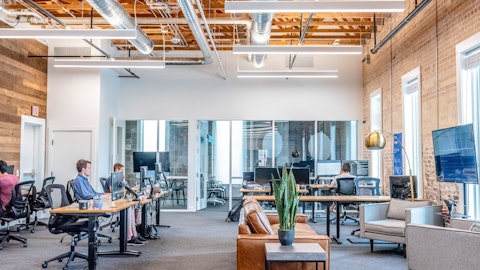Aaron Levie: Yes. And I’ll just build on that. I think I think while we do see headwinds from a macro standpoint, as Dylan called out, healthy pipeline build, the customer conversations we’re having, I think, would definitely lead us to still making sure we’re driving the top line growth side. So as we just think about these toggles, whether it’s our product road map, the strength of our suite offering the momentum we’re seeing as a result of the AI conversations that are albeit early, I think we’re certainly much more focused on going into next year keeping a healthy level of driving demand. So I would just make sure that we’re thoughtful about that.
Chad Bennett: Okay. And then just maybe a quick follow-up. So just in terms of — we’ve had a lot of transition or cross-sell upsell to enterprise plus it’s now kind of approaching the majority, almost 50% of revenue. I think it’s seen a huge improvement year-over-year. So I’m just trying to figure out from a driver standpoint, if we believe this is a potentially a double-digit growth — revenue growth business again, I don’t know if there’s another enterprise plus, so to speak, ahead or another kind of packaging price uplift. But it seems like we’ve monetized a lot of that already. And now really, that growth acceleration will be dependent upon seat growth. Is that a fair characterization?
Aaron Levie: I think what we’ve called out is as we think about the maturity of the enterprise plus kind of tailwind coming to a head and we’re still seeing healthy growth year-on-year as we’ve called out on customers, matriculating to that plan. But as we kind of see that stabilize at a certain kind of rate and our product portfolio expands. We have called out that I would anticipate additional higher-tier plans in the future. So we haven’t exactly talked about timing because some of that relates to our product road map of unannounced products and whatnot. But we’re very thoughtful about making sure that we time that with a point where we have a strong new or multiple new offerings that we can bundle for customers. And again, that will, I think, be another driver of price per seat growth.
when that happens. And then obviously, seat count growth becomes an additional lever. And then our platform kind of API consumption is another growth driver. So we’re extremely confident and feel very, very — just overall bullish on the portfolio of growth drivers we have between seats, platform consumption, price per seat, kind of the vertical expansion efforts and various kind of go to market engine optimization. So multiple levels of levers of growth going forward.
Chad Bennett: Appreciate the color. Thank you.
Aaron Levie: Yes. Thanks.
Operator: Your next question comes from the line of Jason Ader with William Blair. Your line is open.
Jason Ader: Yes, thank you. Good afternoon, guys. Just wanted to try to make sense of some of your commentary on macro. And maybe what’s — can we look at it as historically just how it’s changed from, let’s say, end of last year until today, do you feel like it has improved over the last eight months from just the demand signals. You talked about pipeline, you talked about good traction with some of your large customers. You talked about interest in AI. But maybe just if you can kind of give us a punchline in terms of whether you feel the demand environment is actually improved at all? Or it sort of just continues to be muted.
Aaron Levie: Yes. I think at a more qualitative level, and this is backed up by our deal trends, when I look at our big customer wins, the verticals, expansion, et cetera, I think we saw sort of the added and increased pressure go from last year’s Q3 and Q4 coming into the year, that was sort of the ramp-up as we headed into this year was sort of where the macro started to flow into the business that we saw. I think we’re — and I’ll let Dylan build on this as he sees fit. But I think we’re at the more stabilization period of that. We’re now lapping that year of that initial impact. And so we see some positive signs of when you kind of look on the year-over-year basis, coming into the second-half of the year, multiple metrics start to improve as a result of that.
Obviously, the nature of the SaaS model and just the fact that you — both the SaaS dynamics, but also just the seat dynamic of the business, you sometimes have a macro trend that can be offset a little bit from where it shows up in the numbers. But I think we’re at a point where when I look at the pipeline build the kind of color and the customer conversations that we’re having, the industries across our 1000-plus wins, it’s really every single industry is represented, financial services, health care, technology, kind of really across the board. So I think there’s a bunch of positives in the data, but just at a more muted level because that seat count growth that is obviously core to our engine has been more muted as a result of the macro.
Dylan Smith: Yes. And just to build on that a bit, I would say to clarify that over the earlier part of the year, so if you’re saying comparing when we enter the year versus what we’ve seen would certainly call out and have called out that there have been some incremental headwinds and impacts related to the macroeconomic environment, but again, optimistic that we’re seeing that stabilization now and everything we are talking about, it’s true around the AI excitement, the pipeline that we’re starting to see build at healthier levels. But that’s not going to show up in this year’s top line outlook just because of the timing and with AI, for example, we’re not monetizing that as of yet. So that’s more of a next year type impact.
Jason Ader: Okay. So fair to say that things kind of have dipped a little bit since the beginning of the year, but now instead of continuing to dip, they sort of seem to be stabilizing.
Dylan Smith: That’s exactly right.
Jason Ader: Okay. All right. And then on AI, Aaron, just from a monetization standpoint, is it right to think there’s sort of two main methods for you to monetize. One is kind of a seed price uplift where you add this AI functionality where people can ask questions of their box content. And then secondly would be kind of API consumption where some external app wants to leverage the Box content cloud for some external app, and they use an API to kind of talk to you — talk to the Box content. Is that correct?
Aaron Levie: Yes. That’s the right way to think about it philosophically. On the former part of the pricing component, I’ll just note that we haven’t announced yet what that will look like and where that may or may not be included. But those dynamics of — there’s a per seat component of Box AI that will have some set of functionality. And then there’s a platform component of Box AI that will be more consumption driven. Those are the right ways to think about how the product will manifest from a pricing packaging standpoint.
Jason Ader: And have you given any specific timing or any kind of general timing around when any of these things will be material or start to contribute to revenue?
Aaron Levie: Yes. We haven’t given that timing only because I think even as we look at the rest of the market and where other kind of enterprise software platforms are, I think, the dynamic is – generally, this is the year where a lot of the technology is getting built. I think customers are starting to think about how they’re going to incorporate this into their workflows and organizations, as well as get expanded budget from an IT standpoint. So I think as Dylan just called out, probably this would be more of an element for next year’s plan. But right now, it’s certainly a driver of the vast majority of CIO conversations that we’re having just because everybody is really figuring out where — what is their AI strategy going to look like?



